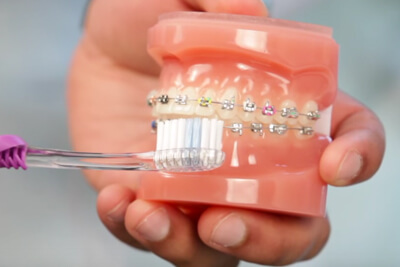
With the celebratory mood of Diwali, Halloween, and Christmas, the old adage, “prevention is the best medicine,” holds true for maintaining a healthy smile. With all the tempting treats this season the importance of brushing and flossing are integral to keeping your teeth clean. Here’s a few quick rules to help you along the way.
Brushing
Brushing with braces is virtually the same as brushing without braces. Those individuals with braces will need to brush more often and should do so when they wake up, before going to bed, and after every meal. This helps to remove food from braces, prevents stains, and cavities.
It is very important that you brush all the surfaces of the teeth including the biting and insides surfaces, along with the front sides. An easy way to do this is by angling your toothbrush towards the gums and very lightly moving the bristles of the toothbrush between the wires and braces. Ensure you gently wiggle the toothbrush back and forth until every tooth is clean. Next – very lightly brush near the gum line of your teeth to ensure that your gums are also healthy.
Note that you should brush for a minute and a half to two minutes each time you brush to ensure that all surfaces are properly reached. Brushing for less is a sure way to make sure that you have not cleaned all your teeth properly.
Keeping your toothbrush clean and new is important to good brushing with them. Be sure to change your toothbrush every three months, or if there is any wear showing on the bristles. Another good idea is to replace it after a cold, because the germs are able to reside deep within the brush.
After delving into your favorite sweet treat, it’s very important to clear away the residual sugar that may rest on teeth. Overtime, it is this little bit of sugar that can lead to large cavities requiring fillings and root canals. We always recommend our patients to brush after a sugar heavy snack or at least rinse their mouth with water. Though rinsing is not a substitute for brushing, a rinse will act to wash away the sugar from the mouth and create a much healthier environment for teeth.
Flossing
Flossing can be tricky, but is critical to your health. Flossing helps, us reach surfaces of the teeth where a toothbrush cannot reach. This is why you should floss at least once a day. Make sure to use a piece of floss that is long enough, typically the size of a 30cm ruler. Wrap one end around your index finger tightly and the other end around your other index finger. It is important that the floss is tight but not uncomfortable for your fingers.
- Slide the floss in between the teeth
- Push against the side of one tooth and slide the floss up and down
- Make sure to go under your gum line – not too far, but just enough to remove debris.
- Once you get used to flossing, you will know how far below the gum line you can actually go.
- Repeat for the next tooth.
If you do not have braces, flossing is relatively easy; for individuals with braces, a floss threader will be needed in addition to floss thread behind the braces. New braces wearers have no reason to fret – after a few days of flossing with a threader it becomes almost second nature.
After your brushing and flossing session, rinse and check your teeth. Rinse thoroughly with water or mouth rinse, and examine your teeth in the mirror. They should sparkle, shine and feel clean.





